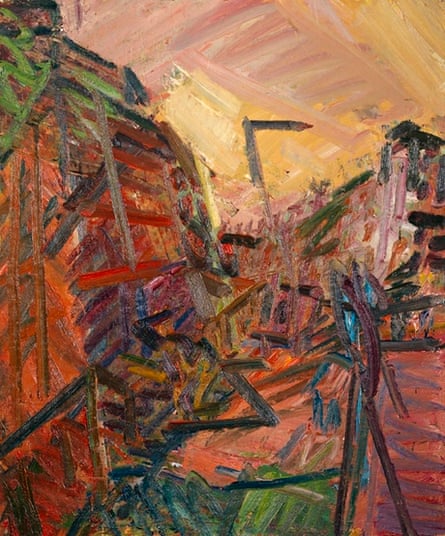London is a city of paint. It may not seem that way. Most people probably visualise the boulevards of Paris and skyscrapers of New York when we think about painted cities: of Camille Pissarro's Boulevard Montmartre, Robert Delaunay's Eiffel Tower or Georgia O'Keeffe's Radiator Building.
How about Frank Auerbach's Rebuilding the Empire Cinema, Leicester Square?
In 1962 Auerbach, who has been painting London for 60 years, depicted the rebuilding of this West End cinema after its ruin in the second world war. The rise of a new postwar city after the Blitz is one of his most pungent themes. Where pop artists in the 1960s dwelt on the brash brightness of the new affluent capital that belatedly took flight 15 years after Hitler's defeat, Auerbach's paintings of London building sites at that time dig deep into pain and loss. It is hard to tell the difference between a building site and an archaeological excavation in his art. The earth disgorges something new, and something old. Brown mud and red girders cut painfully into open wounds.

Rebuilding the Empire Cinema, Leicester Square is now on view in a new exhibition of Auerbach's works at Tate Britain. The show celebrates a significant national inheritance, for it is the Lucian Freud collection of Auerbach's paintings and drawings. Freud's insightful selection of a friend's art has passed to the Arts Council in lieu of inheritance tax, to be allocated to public galleries.
It should all go to Tate Britain, permanently. There's no point in scattering the Freud collection of Auerbach's art around museums in Manchester and Southampton and so forth. For one thing, Auerbach is an outstanding British artist whose reputation really needs securing for the ages – and only the Tate has the global power to do that. Its retrospective of his work next year ought to be a real event.

To be blunt, all too many paintings by the best British artists hang outside London where they don't get the publicity they deserve. The best place in the world to see Auerbach's paintings is in the city where he lives and works. No wonder that in the 1980s Auerbach was often spoken of, along with such artists as Freud, Leon Kossoff and RB Kitaj as belonging to a "School of London". He has literally dug himself into the city and its landscapes. London skies and London spaces energise his mighty, roiling expressionist art.
London is truly a very different kind of art city from Paris or New York. It is – in paintings – tougher and darker. Modern London's art history starts with William Hogarth, who in the Georgian age dwelt on mad houses and gambling dens, brothels and workhouses. Hogarth's London is a practically subterranean place, a cavern peopled by no-hopers. He is an artist who paints the dangers and the victims of city life. Auerbach is one of his true heirs.
Impressionist Paris is an idyll. Auerbach's London is so real it hurts. It is time to do honour to this awe-inspiring artist.

Comments (…)
Sign in or create your Guardian account to join the discussion